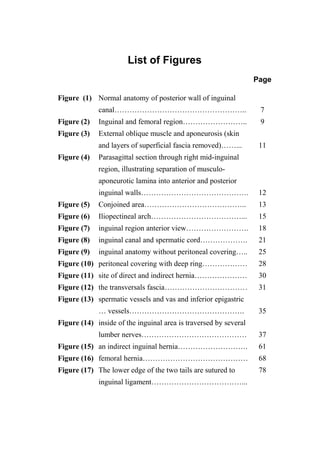List of figures of the work
- 1. List of Figures Page Figure (1) Normal anatomy of posterior wall of inguinal canalâĶâĶâĶâĶâĶâĶâĶâĶâĶâĶâĶâĶâĶâĶâĶâĶâĶ.. 7 Figure (2) Inguinal and femoral regionâĶâĶâĶâĶâĶâĶâĶâĶ.. 9 Figure (3) External oblique muscle and aponeurosis (skin and layers of superficial fascia removed)âĶâĶ... 11 Figure (4) Parasagittal section through right mid-inguinal region, illustrating separation of musculo- aponeurotic lamina into anterior and posterior inguinal wallsâĶâĶâĶâĶâĶâĶâĶâĶâĶâĶâĶâĶâĶâĶ. 12 Figure (5) Conjoined areaâĶâĶâĶâĶâĶâĶâĶâĶâĶâĶâĶâĶâĶ.. 13 Figure (6) Iliopectineal archâĶâĶâĶâĶâĶâĶâĶâĶâĶâĶâĶâĶ... 15 Figure (7) inguinal region anterior viewâĶâĶâĶâĶâĶâĶâĶâĶ. 18 Figure (8) inguinal canal and spermatic cordâĶâĶâĶâĶâĶâĶ. 21 Figure (9) inguinal anatomy without peritoneal coveringâĶ.. 25 Figure (10) peritoneal covering with deep ringâĶâĶâĶâĶâĶâĶ 28 Figure (11) site of direct and indirect herniaâĶâĶâĶâĶâĶâĶâĶ 30 Figure (12) the transversals fasciaâĶâĶâĶâĶâĶâĶâĶâĶâĶâĶâĶ 31 Figure (13) spermatic vessels and vas and inferior epigastric âĶ vesselsâĶâĶâĶâĶâĶâĶâĶâĶâĶâĶâĶâĶâĶâĶâĶ. 35 Figure (14) inside of the inguinal area is traversed by several lumber nervesâĶâĶâĶâĶâĶâĶâĶâĶâĶâĶâĶâĶâĶâĶ 37 Figure (15) an indirect inguinal herniaâĶâĶâĶâĶâĶâĶâĶâĶâĶ. 61 Figure (16) femoral herniaâĶâĶâĶâĶâĶâĶâĶâĶâĶâĶâĶâĶâĶâĶ 68 Figure (17) The lower edge of the two tails are sutured to inguinal ligamentâĶâĶâĶâĶâĶâĶâĶâĶâĶâĶâĶâĶ... 78
- 2. Page Figure (18) The upper edge of the mesh is sutured to the internal oblique aponeurosis and the two tail of the mesh are crossedâĶâĶâĶâĶâĶâĶâĶâĶâĶâĶâĶ. 79 Figure (19) The lower edge of the two tails are sutured to inguinal ligamentâĶâĶâĶâĶâĶâĶâĶâĶâĶâĶâĶâĶ... 80 Figure (20) Trocars positionâĶâĶâĶâĶâĶâĶâĶâĶâĶâĶâĶâĶâĶ 116 Figure (21) Ports position in TAPPâĶâĶâĶâĶâĶâĶâĶâĶâĶâĶ 114 Figure (22) Actual Views â TAPP RepairâĶâĶâĶâĶâĶâĶâĶâĶ 117 Figure (23) Protack used in fixing the mesh in TAPPâĶâĶâĶ.. 118 Figure (24) Positioning of the patient and the teamâĶâĶâĶâĶ.. 121 Figure (25) Ports position in TEPâĶâĶâĶâĶâĶâĶâĶâĶâĶâĶâĶ 122 Figure (26) Incision below umbilicus with retraction rectus muscle to show posterior rectus sheathâĶâĶâĶâĶ. 123 Figure (27) A balloon dissectionâĶâĶâĶâĶâĶâĶâĶâĶâĶâĶâĶ.. 124 Figure (28) Locations of hernia in relation to the epigastric and iliac vesselsâĶâĶâĶâĶâĶâĶâĶâĶâĶâĶâĶâĶâĶ. 126 Figure (29) Dissection of the sacâĶâĶâĶâĶâĶâĶâĶâĶâĶâĶâĶ. 126 Figure (30) Preparing of meshâĶâĶâĶâĶâĶâĶâĶâĶâĶâĶâĶâĶ. 127 Figure (31) Diagram of patient positionâĶâĶâĶâĶâĶâĶâĶâĶ. 132 Figure (32) Ports position âĶâĶâĶâĶâĶâĶâĶâĶ.âĶâĶâĶâĶâĶ.. 132


